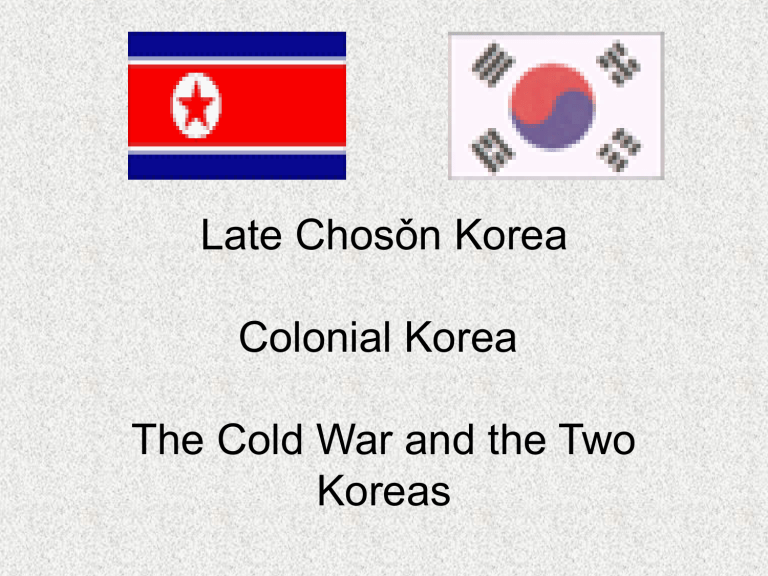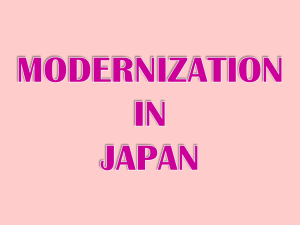Late Chosǒn Korea Colonial Korea The Cold War and the Two Koreas

Late Chosǒn Korea
Colonial Korea
The Cold War and the Two
Koreas
k
• Map of
Korea
• Map of
Asia
Korean Society during the Yi
Dynasty (1392 –1910)
• Ancient Chosǒn: ca. 4th-cent. BC; federation of tribes, capital at modern Pyongyang.
• Yi Dynasty: Victorious general Yi Song-gye established in 1392, with territory under its control named Chosǒn, and received approval of the
Ming emperor.
• Buddhism was originally the state religion for the protection and welfare of the kingdom. After Yi Founding, Confucianism and IN and
Buddhism was OUT.
• Strong Hereditary Monarchies had evolved in an earlier period, and local Korean aristocracy remained strong well after same class faded in China.
• The Yangban was the top social class of the Yi dynasty, consisting of hereditary civilian and military officials. After the Yi Founding, the
Yangban dominated Yi society. Earlier local matrilineal customs had given women great power, however women gradually lost status in Yi society.
Outside Challenges to the “Hermit
Kingdom”
• 1598 Japanese Shogun attempts to invade Korea; repulsed by Ming and Manchu allies.
• 1637 Manchu invasion successful. Manchus soon leave after capturing the young Korean ruler.
• In 1653 a Dutch VOC merchant ship went aground off
Cheju Island, and its 36 surviving crewmen were taken to Seoul for detention. Thirteen years later
Hendrik Hamel and seven others escaped and returned home. Hamel wrote an account of his experiences--the first book on Korea published in
Europe.
Ideological Conflict in Korean
Society
•
Korea's first significant contact with Christianity was through missionaries in
China. Korean envoys to China in the 16th century brought back with them a world atlas and scientific instruments made by the priests, as well as literature on science and Christianity. Common people attracted to Christianity with promises of social equality. Catholicism spread from Seoul to the provinces steadily.
•
In 1715 the Pope sided with the Dominicans (against the Jesuits) and condemned all Confucian ancestor worship as idolatry rituals; this remained the policy of the Catholic Church until the mid-20th century. The Chinese emperor in 1724 then banned Christian missionaries form his empire. The
Korean king Chǒngjo initially tolerated Christian practices among his court members, but in the late 18 th century incidents of anti-Confucian behavior cause the ruler to abandon his tolerant policy.
•
During persecutions in 1801, 1839, and 1866, Korean converts were either put to death or forced to recant; foreign missionaries were often killed. However, commoners continued to support the Catholic church, mostly in secret and beyond urban areas. In 1831 the Vatican established a Korean parish, and
French priests were smuggled into the Korean kingdom for secret proselytizing.
Tonghak Rebellion
• A new religion founded in 1860 by Ch'oe Cheu (1824-
1864), a fallen country yangban scholar, advocated sweeping social reform. It had much in common with traditional animism and appealed to the peasantry. This religion was called Tonghak, or "Eastern Learning," as a counterpoise to Sohak, or "Western Learning"--i.e.,
Catholicism
• Ch'oe Cheu was captured and executed by the Yi court, but his movement flourished underground.
• Outbreak of Tonghak Rebellion in 1894 gave Japanese a pretense for eliminating foreign (i.e. Chinese) influences from the Korean peninsula.
The Forced Entry of the Outside
World into Korea
• "Foreign Disturbance of 1871" : American flotilla of five warships was repulsed and a platoon of marines was driven back.
• Treaty of Kanghwa (1876): ports of Pusan, Wonsan, and Inch'on were opened to Japanese trade. This treaty first brought Korea on to the international diplomatic scene.
• Convention of Tientsin (Tianjin) (1885): treaty signed by the Qing official Li Hung-chang and Japan's Ito Hirobumi; designed to guarantee a Sino-Japanese balance of power on the Korean peninsula.
• Treaty of Shimonoseki (April 17, 1895): agreement at the end of the Sino-Japanese War that, among other concessions, recognized
Korea's "independence" from China.
EARLY KOREAN RADICALISM
• During the Russo-Japanese War (1904-1905), Japanese forces moved onto the peninsula, despite Korean declarations of neutrality.
The signing of the Japan-Korea Protection Treaty in 1905 gave
Japan virtual control over Korea, and in 1910 a Korean royal proclamation announced the annexation by Japan.
• March First Movement: the nationwide anti-Japanese rallies staged on March 1, 1919, during the occasion of mourning the death of Emperor Kojong,
• Syngman Rhee (1875-1965): first president of the Republic of
Korea (South Korea) and first Korean to receive a Ph.D. degree from an American university (Princeton, 1910). He had been n China during WWII, but he returned with US occupation forces. .
• Nai-Sen Ittai: “Japan and Korea are One Entity” was the slogan behind Japanese governmental policy to eradicate Korean national identity, initiated during WWII.






